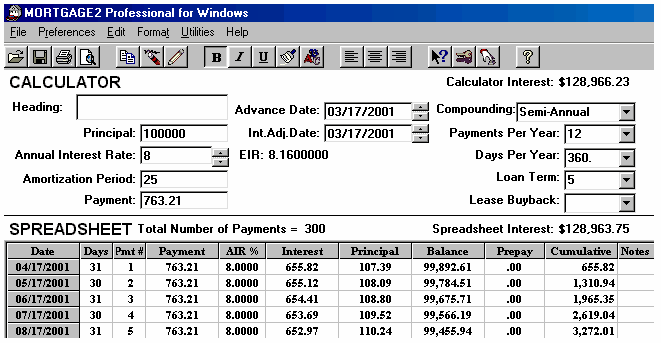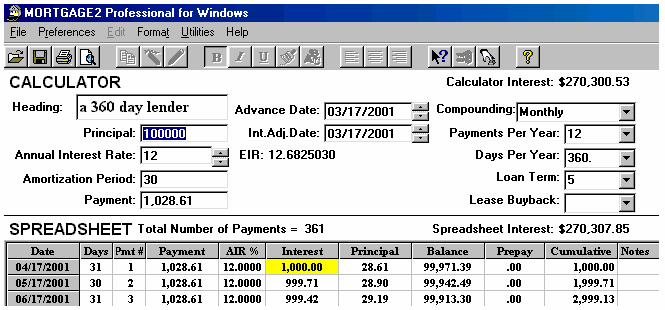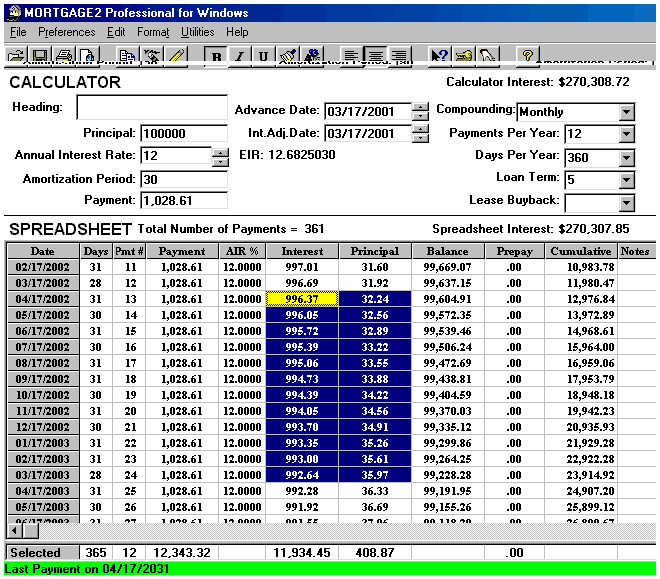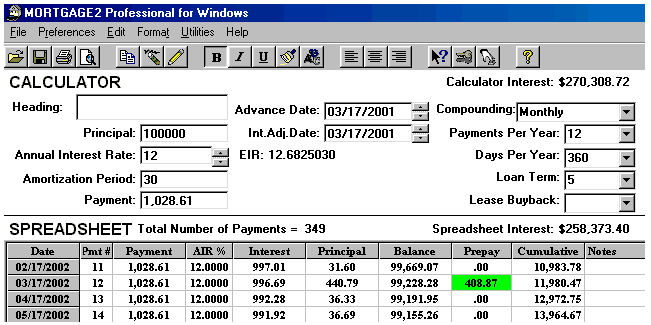Top 10 Reasons You Need an Amortization Schedule
1.Verify the interest factor used in your mortgage. An interest factor is a number used at the end of each payment period to calculate what you owe in interest. The interest factor is also used to calculate the effective interest rate. The effective interest rate is the only way to compare a mortgage to another financial vehicle, such as a mutual fund.
For example, Bob and Jane have a $100,000 mortgage amortized for 25 years with an interest rate of 8% and semi-annual compounding. The monthly payments are $763.21. Bob and Mary are wise enough to have asked for an amortization schedule. They notice that the interest portion of the very first payment is $655.82 thus the interest factor is .0065582. If the breakdown of the very first payment does not agree with an amortization schedule that you know to be correct, do not waste any time analyzing it. Ask your Lender why!!!. The interest for the use of the $100,000 for the very first month is .0065582 x 100,000 = 655.82 and only $107.39 is the amount that the mortgage is reduced, after the first payment of $763.21. The interest factor, .0065582 is the same number used each month for this 8% mortgage to arrive at the interest charges for the use of the money for the month. The only exception to this rule is reason #9 below. Some amortization schedules will display the interest factor in the schedules heading; however it may not shown, for an 365 day year exact day monthly schedule because it changes each month. For a 360 day year schedule, dividing the interest portion of the first payment by the initial value of the mortgage will give you its value to 5 figures. To find out what the effective interest rate is for this 8% mortgage, you add 1 to the interest factor and multiply the number by itself 12 times, then subtract 1. and the answer is 8.16%

A simple trick that works ONLY for semi-annual compounding is to divide the rate by 2, then multiply the answer by itself, move the decimal place two places to the left and add it to the initial rate, .. result is 8.16%
8/2=4 4×4=16 16/100=0.16 8+0.16=8.16%
Try it, 12% semi-annual compounding is an effective rate of 12.36% All effective rates are assumed to be on annual basis by convention. You need to know the interest factor if you want to know your EFFECTIVE INTEREST RATE. If you want to compare your mortgage to other financial vehicles then you must know your mortgages affective interest rate, in order to compare it to the “annual rate of return” or “yield”. A 12% nominal rate with monthly compounding is equivalent to an effective interest rate of 12.6825% (1.01 multiplied by itself 12 times minus 1.0). Ask you lender what the effective interest rate is on your mortgage, you may be surprised! You may be even more surprised or astonished at your lenders response if you ask for it in writing! It is a fact, there are lenders in North America charging borrowers extra interest each year, due to errors, but they will never know unless they have an amortization schedule.
AMERICAN-CANADIAN EXAMPLE
Let’s use another example, to explain interest factors that is applicable to both Americans and Canadians. A $100,000 mortgage amortized for 30 years, with an annual interest rate of 12% and monthly compounding. The $100,000 was advanced on March 17, 2001 therefore the first blended monthly payment of $1,028.61 is due April 17th as shown below. The interest portion (yellow) of the first payment is $1000 and only $28.61 goes towards paying down the principal. The interest factor is 0.01

Whether the Lender uses the 360 day year method or the 365 day year method the calculated blended monthly payment would be the same on any financial calculator. The mathematics of amortization assume the year is divided into 12 equal months. All calculators and software will calculate the same monthly payment of $1,028.61, for this example. Only an amortization schedule will tell you if the lender is using the 365 exact day monthly method. Shown below is the same example but using the 365 exact day monthly method.

The interest factor for the first payment is based upon a 31 day period from March 17th to April 17th and thus a higher interest cost of $1,019.28
It is interesting to note, the 360 day method actually implies that the month has 30.41666666 days (365/12) as can be seen from the factor calculator below;

Note! .0099999999977 is the same as .01 for all practical purposes in the above screen.
2. Prepay your mortgage in a more informative way. For example, prepaying all of the second years principal payments (#13 to #24) along with the 12th blended payment saves you exactly, the second years interest. The second year of the amortization schedule vanishes and you know exactly what savings you achieved. The savings achieved by prepaying are yours for the asking , all you need is an amortization schedule. If one methodically prepays their mortgage exactly as outlined they would only really need one amortization schedule.

Lines 13 to 24 where highlighted in the SPREADSHEET to show that the total principal to be paid in the second year is as per the schedule is $408.87 and the total interest in the second year as per the schedule is $11,934.45
If the $408.87 is paid along with the 12th payment as a prepayment ( the green cell) then the 2nd years interest of $11,934.45 is saved and the schedule is reduced by one year.

The initial Spreadsheet Interest was $270,307.85 and subtract the new Spreadsheet Interest of $258,373.40 and the savings are $11,934.45 which is exactly the 2nd years interest as shown in the initial schedule.
3. Blended rates may not save you money! Some lenders will offer you a blended rate mortgage (or consolidate two loans) rather than allow you to pay the Interest Rate Differential, IRD or the three month interest penalty. A wise rule is to not buy into anything you cannot calculate or understand. To verify a blended rate for two loan scenarios you need three amortization schedules, two before and one after. The very fact the lender is blending the rates is an indication they may not want you to be able to calculate or pay the IRD and compare costs!
4. You may verify Interest Rate Differential (IRD). To verify the IRD, you need two amortization schedules. You add the IRD to the initial balance of the loan at the lower rate, and the balance owing after the same time periods must be identical, if not, the IRD is incorrect. The IRD is a fair and accurate method for compensating the lender because of your premature exit from a mortgage before the term expires. For example, most Banks in Canada try to match the terms of Guaranteed Investment Certificates (GIC) with mortgage terms. Expecting a lender to allow you to exit a mortgage without paying an IRD is unrealistic because someone else would have to accept a lower interest rate on their GIC (lower return or lower yield).
5. Beware of some “Reduced Rate of Return Loans”. A lender offers a lower interest rate on a specific type of mortgage thus supposedly saving you money in interest. The Lender does this benevolent gesture (lowering the interest rate) by lengthening the amortization period. Buyer Beware!, This is pure nonsense!!! Increasing the amortization period will offset the lower interest rate! In fact you can calculate exactly how much to lengthen the amortization period in order to compensate for the lower interest rate.
6. See your outstanding balance at a glance. You are more likely to plan and budget for the future when you are aware of the balance owing at any point in the life of the mortgage. Some lenders allow you to skip payments as a convenient feature to help with cash flow problems, especially around Christmas time. An amortization schedule is invaluable in making the decision to skip three payments. In the MORTGAGE2 PRO software package it is as easy as typing in three zero payments and noting the difference in the interest costs. You may be shocked at the results. The old adage is once again true, … “you do not get anything for nothing”. For example, skipping the first three blended payments, on a $150,000 mortgage at 6% with semi-annual compounding amortized for 25 years costs you at least an extra $10,000 in interest.
7. If you have a declining interest rate mortgage, or an adjustable rate mortgage, ARM, are you really saving money? This can be very difficult to compare because the lender may keep the payment constant or let the payment decrease and thus add to the complexity. This type of amortization schedule or series of amortization schedules are invaluable in the process of verifying of your savings. Unless your are proficient at Excel or have MORTGAGE2 PRO software verifying ARMS is time consuming and tedious.
8. The impact of fees or interest adjustments are immediately obvious if you have an amortization schedule in your hands. Sometimes these two items show up as negative prepayments in the prepayment column of the amortization schedule. Negative prepayments are added directly onto your balance owing, thus increasing interest costs!
9. If the Lender uses the 365 exact day method of interest calculation for a monthly payment mortgage you are paying more in interest (as compared to the 360 day year method as mentioned in reason #1 above). A lender utilizing the exact day interest method would typically earn an extra $315 on a $100,000 mortgage at 8% over the twenty five years.
10.You will know if the Lender is making errors on your mortgage or loan! In North America, millions of dollars annually in needless interest are being paid to lenders because of undetected errors in payment schedules. Some lenders do the calculations manually each month and are prone to errors. Some lenders use out dated mainframe software that has been retrofitted to work on newer computers.
